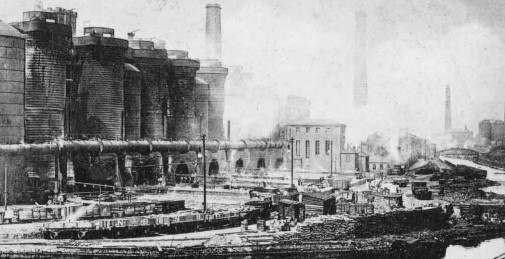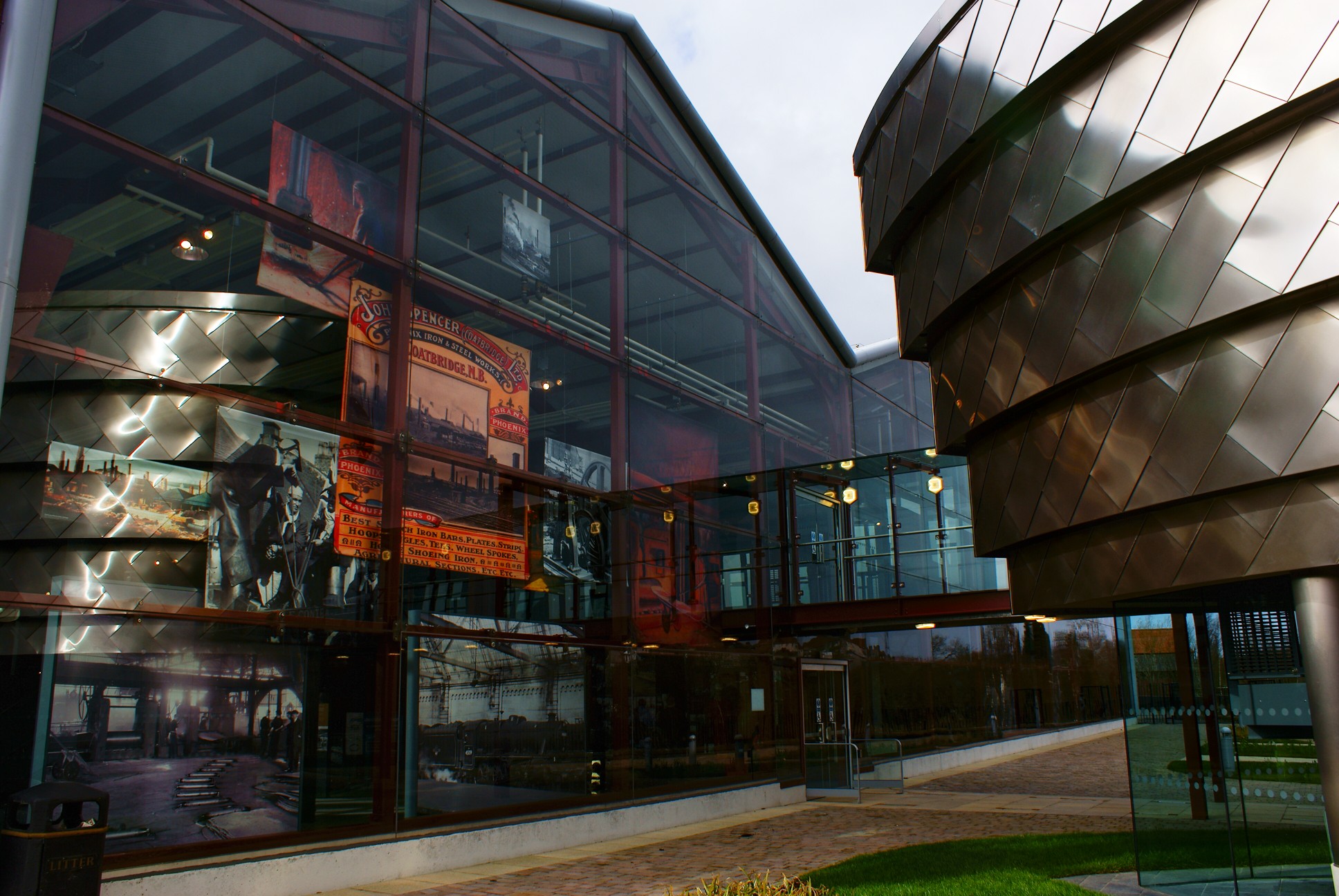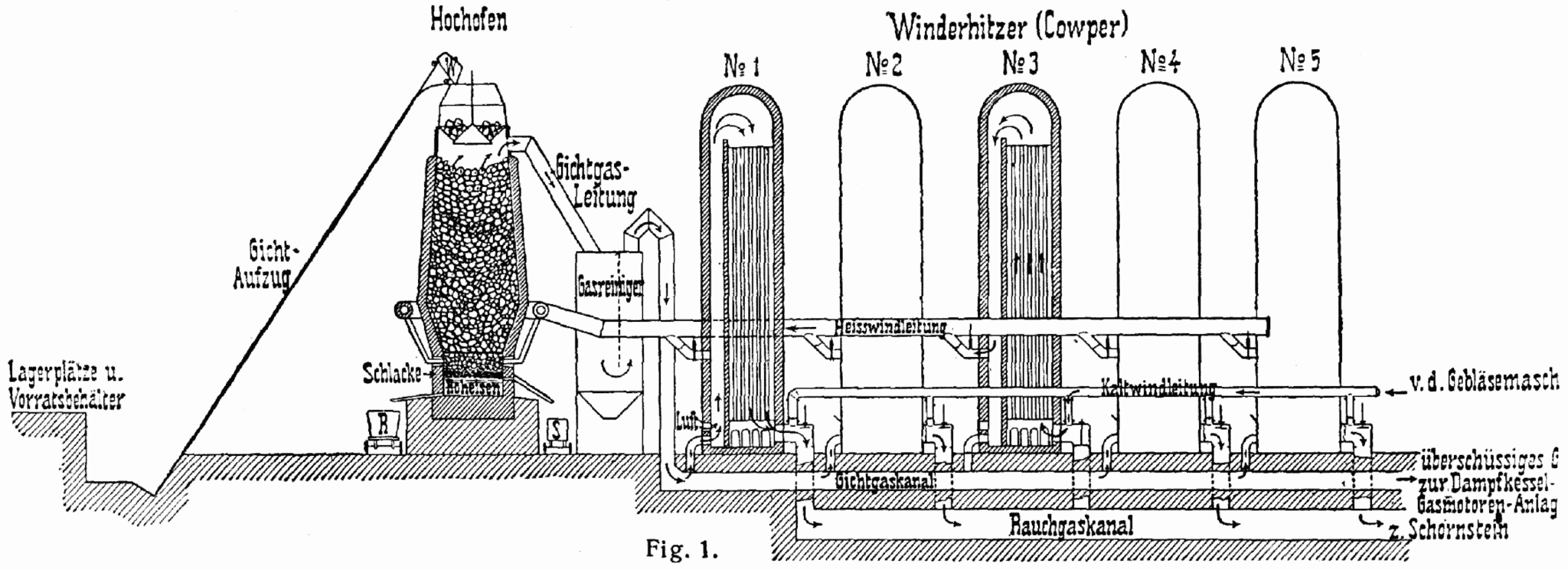|
Summerlee Iron Works
The Summerlee Iron Works (1836–1930) was an iron works established in Coatbridge, Scotland. The site has been incorporated into the Summerlee, Museum of Scottish Industrial Life. History The Summerlee Iron Works was an early adopter of the ' Hot Blast Process', recently patented by James Beaumont Neilson in 1828. This process burned waste furnace gases in regenerative stoves, to heat up a lattice of fire bricks inside them. Once the bricks were sufficiently heated, the waste furnace gases were purged and replaced by fresh air intended to fire the furnaces. The fire bricks transferred their heat to this air, turning it into the 'hot blast' pumped into the furnaces. No traces of the original small rectangular stoves remain, but foundations of the round Cowper Stoves, that were as tall as the furnaces themselves (20 m) and installed in the 1870s, are visible. The iron works closed in the early 1930s during the Great Depression and was demolished in 1938. Additional demolition ... [...More Info...] [...Related Items...] OR: [Wikipedia] [Google] [Baidu] |
Coatbridge
Coatbridge ( sco, Cotbrig or Coatbrig, gd, Drochaid a' Chòta) is a town in North Lanarkshire, Scotland, about east of Glasgow city centre, set in the central Lowlands. Along with neighbouring town Airdrie, Coatbridge forms the area known as the Monklands (population approximately 90,000 including outlying settlements), often considered to be part of the Greater Glasgow urban area – although officially they have not been included in population figures since 2016 due to small gaps between the Monklands and Glasgow built-up areas. In the last years of the 18th century, the area developed from a loose collection of hamlets into the town of Coatbridge. The town's development and growth have been intimately connected with the technological advances of the Industrial Revolution, and in particular with the hot blast process. Coatbridge was a major Scottish centre for iron works and coal mining during the 19th century and was then described as 'the industrial heartland of Scotland' ... [...More Info...] [...Related Items...] OR: [Wikipedia] [Google] [Baidu] |
Iron Works
An ironworks or iron works is an industrial plant where iron is smelted and where heavy iron and steel products are made. The term is both singular and plural, i.e. the singular of ''ironworks'' is ''ironworks''. Ironworks succeeded bloomeries when blast furnaces replaced former methods. An integrated ironworks in the 19th century usually included one or more blast furnaces and a number of puddling furnaces or a foundry with or without other kinds of ironworks. After the invention of the Bessemer process, converters became widespread, and the appellation steelworks replaced ironworks. The processes carried at ironworks are usually described as ferrous metallurgy, but the term siderurgy is also occasionally used. This is derived from the Greek words ''sideros'' - iron and ''ergon'' or ''ergos'' - work. This is an unusual term in English, and it is best regarded as an anglicisation of a term used in French, Spanish, and other Romance languages. Historically, it is common ... [...More Info...] [...Related Items...] OR: [Wikipedia] [Google] [Baidu] |
Scotland
Scotland (, ) is a country that is part of the United Kingdom. Covering the northern third of the island of Great Britain, mainland Scotland has a border with England to the southeast and is otherwise surrounded by the Atlantic Ocean to the north and west, the North Sea to the northeast and east, and the Irish Sea to the south. It also contains more than 790 islands, principally in the archipelagos of the Hebrides and the Northern Isles. Most of the population, including the capital Edinburgh, is concentrated in the Central Belt—the plain between the Scottish Highlands and the Southern Uplands—in the Scottish Lowlands. Scotland is divided into 32 administrative subdivisions or local authorities, known as council areas. Glasgow City is the largest council area in terms of population, with Highland being the largest in terms of area. Limited self-governing power, covering matters such as education, social services and roads and transportation, is devolved from the Scott ... [...More Info...] [...Related Items...] OR: [Wikipedia] [Google] [Baidu] |
Summerlee, Museum Of Scottish Industrial Life
Summerlee Museum of Scottish Industrial Life is an industrial and social history museum in Coatbridge, North Lanarkshire, Scotland. It is situated on the site of the Victorian Summerlee Iron Works and the former Hydrocon Crane factory. The main Hydrocon factory building became the museum’s exhibition hall but it has been substantially changed and adapted since. The museum aims to show Lanarkshire's contribution to engineering, mining, steel working, weaving and farming, and also show the lives of the people of the area. It includes interactive displays and a temporary exhibition space. Entry is free of charge. The museum also incorporates several railway steam locomotives, preserved railway carriages from a 1960s-era Glasgow Class 311 and has a short working heritage tram line. The museum covers 22 acres and includes two scheduled monuments, Summerlee Iron Works and the Monkland Canal, a large play area, mine and miners' row, outdoor exhibits, a cafe, changing place, ... [...More Info...] [...Related Items...] OR: [Wikipedia] [Google] [Baidu] |
Hot Blast
Hot blast refers to the preheating of air blown into a blast furnace or other metallurgical process. As this considerably reduced the fuel consumed, hot blast was one of the most important technologies developed during the Industrial Revolution. Hot blast also allowed higher furnace temperatures, which increased the capacity of furnaces. As first developed, it worked by alternately storing heat from the furnace flue gas in a firebrick-lined vessel with multiple chambers, then blowing combustion air through the hot chamber. This is known as regenerative heating. Hot blast was invented and patented for iron furnaces by James Beaumont Neilson in 1828 at Wilsontown Ironworks in Scotland, but was later applied in other contexts, including late bloomeries. Later the carbon monoxide in the flue gas was burned to provide additional heat. History Invention and spread James Beaumont Neilson, previously foreman at Glasgow gas works, invented the system of preheating the blast for a ... [...More Info...] [...Related Items...] OR: [Wikipedia] [Google] [Baidu] |
James Beaumont Neilson
James Beaumont Neilson (22 June 1792 – 18 January 1865) was a Scotland, Scottish inventor whose hot blast, hot-blast process greatly increased the efficiency of smelting iron. Life He was the son of the engineer Walter Neilson, a millwright and later steam engine, engine wright, who had been a partner of David Mushet in Calder Ironworks, Glasgow.W. K. V. Gale, ''British iron and steel industry'' (David and Charles, Newton Abbot 1967), 55-8. He was born in Shettleston and was trained as an engine wright. After the failure of a colliery at Irvine, North Ayrshire, Irvine he was appointed foreman of the Glasgow Gasworks in 1817 at the age of 25. Five years later he became the manager and engineer there, a position he held for 40 years. While trying to solve a problem with a blast furnace at Wilsontown Ironworks, Neilson realized that the fuel efficiency of the furnace could be increased by blowing it with hot air, rather than cold air, by passing it through a red-hot vesse ... [...More Info...] [...Related Items...] OR: [Wikipedia] [Google] [Baidu] |
Regenerative Heat Exchanger
A regenerative heat exchanger, or more commonly a regenerator, is a type of heat exchanger where heat from the hot fluid is intermittently stored in a thermal storage medium before it is transferred to the cold fluid. To accomplish this the hot fluid is brought into contact with the heat storage medium, then the fluid is displaced with the cold fluid, which absorbs the heat. In regenerative heat exchangers, the fluid on either side of the heat exchanger can be the same fluid. The fluid may go through an external processing step, and then it is flowed back through the heat exchanger in the opposite direction for further processing. Usually the application will use this process cyclically or repetitively. Regenerative heating was one of the most important technologies developed during the Industrial Revolution when it was used in the hot blast process on blast furnaces. It was later used in glass melting furnaces and steel making, to increase the efficiency of open hearth furnaces, ... [...More Info...] [...Related Items...] OR: [Wikipedia] [Google] [Baidu] |
Edward Alfred Cowper
Edward Alfred Cowper (10 December 1819 London – 9 May 1893 Rastricke, Weybridge, Surrey) was a British mechanical engineer. Biography He was born on 10 December 1819 in London to professor Edward Shickle Cowper (1790–1852), head of the department of engineering at King's College London; and Ann Applegath. The elder Cowper, together with his brother-in-law Augustus Applegath, had helped to develop the vertical printing press in the 1820s. In 1833, he was apprenticed to John Braithwaite, a railway engineer in London. In around 1841, he invented the detonating railway fog signal, first tried on the Croydon railway and widely used to this day as an emergency safety measure. The same year, he joined Fox, Henderson and Co, structural and railway engineers in Smethwick, where he devised a method of casting railway chairs. He oversaw the company's contract drawings for the 1851 Exhibition Building, The Crystal Palace. Cowper also designed the wrought-iron and glass roof of Birm ... [...More Info...] [...Related Items...] OR: [Wikipedia] [Google] [Baidu] |
Great Depression
The Great Depression (19291939) was an economic shock that impacted most countries across the world. It was a period of economic depression that became evident after a major fall in stock prices in the United States. The economic contagion began around September and led to the Wall Street stock market crash of October 24 (Black Thursday). It was the longest, deepest, and most widespread depression of the 20th century. Between 1929 and 1932, worldwide gross domestic product (GDP) fell by an estimated 15%. By comparison, worldwide GDP fell by less than 1% from 2008 to 2009 during the Great Recession. Some economies started to recover by the mid-1930s. However, in many countries, the negative effects of the Great Depression lasted until the beginning of World War II. Devastating effects were seen in both rich and poor countries with falling personal income, prices, tax revenues, and profits. International trade fell by more than 50%, unemployment in the U.S. rose to 23% and ... [...More Info...] [...Related Items...] OR: [Wikipedia] [Google] [Baidu] |
Manpower Services Commission
The Manpower Services Commission (MSC) was a non-departmental public body of the Department of Employment Group in the United Kingdom created by Edward Heath's Conservative Government in 1973. The MSC had a remit to co-ordinate employment and training services in the UK through a ten-member commission drawn from industry, trade unions, local authorities and education interests. This was an example of the contemporary corporatist influence on British economic policy. With three executive agencies, the Employment Services Division, the Training Services Division and the Special Programmes Division, the body was led by Geoffrey Holland of the Policy and Planning Division under the overall management of Sir John Cassells. The Policy and Planning Division was initially based in Selkirk House, High Holborn, London and later moved to Moorfoot in Sheffield. At Selkirk House a team of Policy makers took responsibility for putting Geoffrey Holland's 'Young People and Work' report of 197 ... [...More Info...] [...Related Items...] OR: [Wikipedia] [Google] [Baidu] |
1836 Establishments In Scotland
Events January–March * January 1 – Queen Maria II of Portugal marries Prince Ferdinand Augustus Francis Anthony of Saxe-Coburg-Gotha. * January 5 – Davy Crockett arrives in Texas. * January 12 ** , with Charles Darwin on board, reaches Sydney. ** Will County, Illinois, is formed. * February 8 – London and Greenwich Railway opens its first section, the first railway in London, England. * February 16 – A fire at the Lahaman Theatre in Saint Petersburg kills 126 people."Fires, Great", in ''The Insurance Cyclopeadia: Being an Historical Treasury of Events and Circumstances Connected with the Origin and Progress of Insurance'', Cornelius Walford, ed. (C. and E. Layton, 1876) p76 * February 23 – Texas Revolution: The Battle of the Alamo begins, with an American settler army surrounded by the Mexican Army, under Santa Anna. * February 25 – Samuel Colt receives a United States patent for the Colt revolver, the first revolving barrel multishot firearm. * March 1 – ... [...More Info...] [...Related Items...] OR: [Wikipedia] [Google] [Baidu] |








